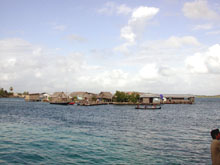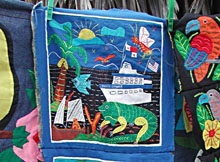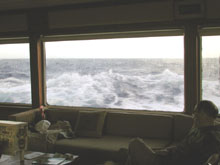
A small part of the San Blas Islands.
The mainland of Panama is to the left.
Click on the following
thumbnails for larger views
 .....
..... .....
.....
The Kuna people have been leaders in indigenous rights and preservation of the natural resources on which they depend. With the help of the World Wildlife Fund and other institutions, they have established a 600-square-kilometer forest reserve on their lands, an example for indigenous people world-wide.
Kuna women are known for their colorful costumes which consist of a patterned blue cotton-wrapped skirt, red and yellow head scarf, arm and leg beads, gold nose rings and earrings and the intricately-sewn mola panel blouse. The mola panels of the blouse are hand-woven in a reverse appliqué technique using several layers of cotton fabric, each layer a different color. The mola may also be decorated with very fine embroidery.
Mola panels have become much sought after and collected examples of textile folk art. The artistry of a mola reflects a synthesis of traditional Kuna culture with the influences of the modern world. Molas developed when Kuna women had access to store-bought yard goods and are often inspired by modern graphics such as political posters, labels, pictures from books, and modern technology as well as themes from traditional Kuna legends. Kuna women spend hours sewing panels for their blouses. When they tire of a particular blouse, they disassemble it and sell the molas to collectors.
The most valued molas are the ones that have actually been worn as part of a Kuna woman's costume. Of course, the Kunas, being very creative people, have adapted the mola technique to other uses and now produce mola designs on a variety of useful objects such as pot holders, bags, eyeglass cases, stuffed animals, Christmas decorations, and pop can insulators!
While these items are not traditional, they demonstrate the Kuna's ability to adapt to the modern world and turn it to their advantage. The sale of these crafts enables them to have a cash income which they need for their children's education, medical care and other necessities.

A small part of the San Blas Islands.
The mainland of Panama is to the left.
Click on the following
thumbnails for larger views
 .....
..... .....
.....


From Colon we traveled by bus across the isthmus to Panama City and the airport to return to our homes. It must have been an interesting trip; it took me two months to prepare this set of web pages!
Good sailing to all,
-Jack and Rita Yeazel